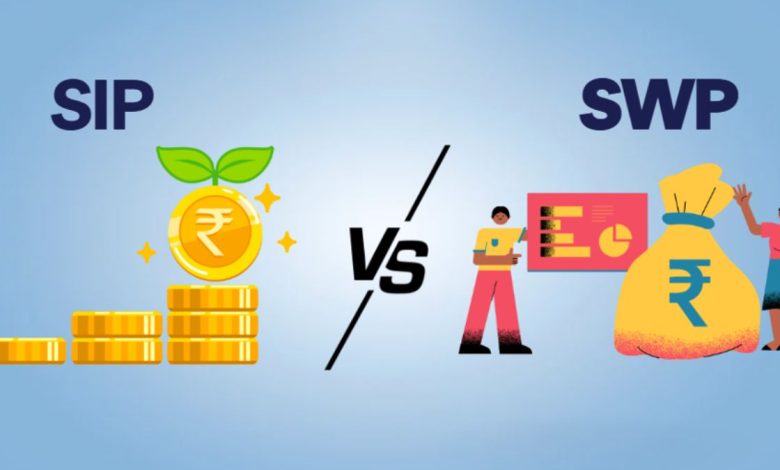SIP vs SWP: Difference, Benefits, and Which Calculator to Use

Wealth accumulation and distribution operate as inverse financial operations—one methodically builds capital while the other strategically deploys it. Systematic Investment Plans (SIP) and Systematic Withdrawal Plans (SWP) represent this duality in action, transforming abstract market participation into engineered cashflow systems. Their calculators—the SIP return calculator and SWP calculator—serve as algorithmic architects for these opposing yet complementary processes.
SIP: The Capital Compounding Engine
SIP functions as a capital synthesis mechanism:
- Periodic accretion: investments of a predefined amount done at frequent intervals
- Volatility arbitrage: Automated averaging of rupee costs during market volatility
- Compound acceleration: Reinvested returns amplifying base principal growth
The mathematical foundation lies in future value calculation:
FV = P × [(1 + r)^n – 1] / r × (1 + r)
Where P = periodic investment, *r* = return rate per period, *n* = total periods. This formula underpins all SIP return calculator outputs, projecting terminal values through recursive compounding.
SIP Calculator: Parametric Growth Simulation
Angel One’s SIP return calculator transforms variables into visual forecasts:
- Principal Input: Monthly investment amount (₹500 – ₹200,000)
- Duration Slider: Investment horizon (1-30 years)
- Return Assumption: Customizable CAGR (5%-30%)
The algorithm generates:
- Growth visualization: Color-coded principal/earnings segregation
- Milestone mapping: Year-by-year value projections
- Sensitivity analysis: ±2% return variance impact displays
This allows testing 134,400 scenario combinations before commitment.
SWP: The Capital Decumulation Framework
SWP inverts SIP’s logic through controlled dissipation:
- Liquidity engineering: Regular withdrawals preserving principal integrity
- Tax optimization: Capital gains distribution sequencing
- Longevity hedging: Perpetual income potential via principal protection
Its core calculation:
Withdrawal = [P × r × (1 + r)^n] / [(1 + r)^n – 1]
where *r* stands for periodic return, *n* for withdrawal intervals, and P for corpus. This ensures sustainable extraction without corpus depletion.
SWP Calculator: Withdrawal Thermodynamics
The SWP calculator models entropy management:
| Input | Impact on Withdrawal Sustainability |
| Corpus Increase (₹) | Linear withdrawal enhancement |
| Duration Extension | Exponential sustainability decrease |
| Return Uplift (%) | Logarithmic withdrawal growth |
Users manipulate:
- Corpus size(₹100,000 – ₹10 crore)
- Withdrawal frequency(monthly/quarterly)
- Growth assumption(4%-15% annual)
Outputs include depletion timelines and tax-efficient withdrawal sequencing.
Operational Symbiosis: SIP→SWP Transition
The calculators reveal optimal transition thresholds:
SIP Maturity Value ≥ SWP Initial Corpus × (1 + Inflation)^n
Where *n* = years until withdrawal initiation. This determines when to shift:
- Aggressive accumulation: Continue SIP if gap >15%
- Transition trigger: Switch when gap <5%
- Conservative decumulation: Initiate SWP immediately if negative gap
Tax Differential Matrix
| Factor | SIP | SWP |
| Equity LTCG | 10% > ₹1 lakh gains | First withdrawals = principal (0%) |
| Debt Fund Taxation | Slab rate after 3 years | Withdrawal sequencing optimization |
| Indexation Benefit | Not applicable | Available for inflation adjustment |
The SWP calculator incorporates this through withdrawal tiering—prioritizing principal extraction.
Behavioral Guardrails
Both systems counteract psychological pitfalls:
- SIP: Automates buying during market pessimism
- SWP: Prevents overspending during bull markets
Calculators enforce discipline through immutable mathematical outputs rather than emotional decisions.
Calculator Integration Protocol
- Accumulation Phase: Use SIP return calculator to determine:
- Monthly investment needed for target corpus
- Required CAGR for goal achievement
- Corpus Transition: Employ both calculators to identify shift timing
- Distribution Phase: Configure SWP calculatorfor:
- Inflation-adjusted withdrawals
- Tax-optimized extraction sequence
SIP and SWP represent the inhalation and exhalation of financial respiration—one gathers market energy, the other releases stored value. Their calculators serve as the diaphragm regulating this cycle. For disciplined investors, the SIP return calculator designs the accumulation architecture while the SWP calculator engineers sustainable distribution, together forming a perpetual wealth circulation system.




